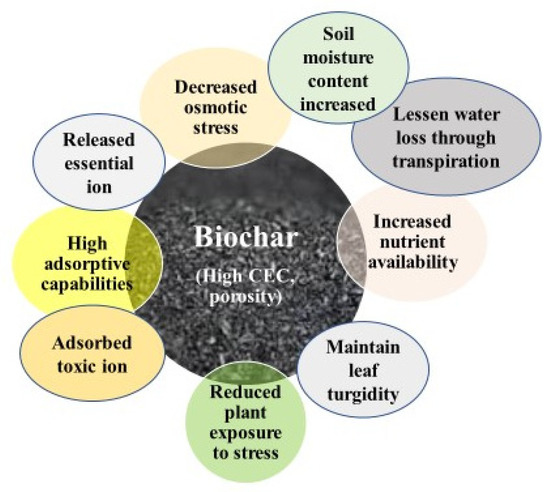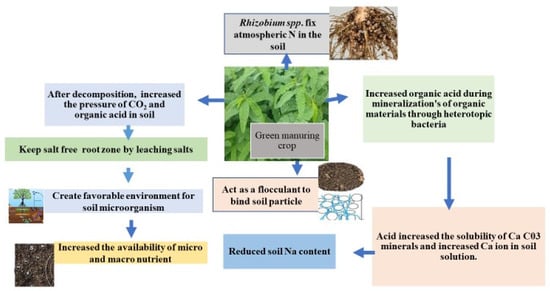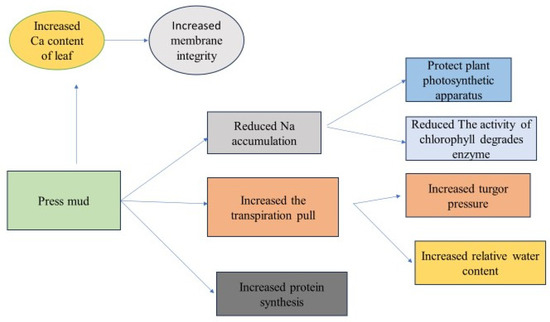Salinity and metal stress are significant abiotic factors that negatively influence plant growth and development. These factors lead to diminished agricultural yields on a global scale. Organic amendments have emerged as a potential solution for mitigating the adverse effects of salinity and metal stress on plants. When plants experience these stresses, they produce reactive oxygen species, which can impair protein synthesis and damage cellular membranes. Organic amendments, including biochar, vermicompost, green manure, and farmyard manure, have been shown to facilitate soil nitrogen uptake, an essential component for protein synthesis, and enhance various plant processes such as metabolism, protein accumulation, and antioxidant activities. Researchers have observed that the application of organic amendments improves plant stress tolerance, plant growth, and yield.
- salinity and metal stress
- organic amendments
- biochar
- compost
- vermicompost
- green manure
- duckweed
- poultry manure
- press mud
1. Introduction

2. Biochar
Biochar, a carbon © rich byproduct of biomass pyrolysis, contains various amounts of C, hydrogen (H), sulfur (S), oxygen (O2), N, and minerals. Although almost 70% of its composition is C, the rest depends on the feedstock used to make it. It has recently been recognized for its beneficial economic and environmental impacts on soil and crop productivity. Biochar amends pH, increases CEC, sequesters C, enhances P availability [19][38], improves soil aeration and porosity [20][21][39,40], and enhances soil fertility [22][23][24][25][41,42,43,44]. Additionally, by promoting the rhizosphere’s biological environment with biochar, soil enzyme activity and microbial growth are enhanced [26][45]. It also assists in nutrient retention in soil micropores and supports easy plant nutrient assimilation [27][46]. Salinity is mitigated by replacing Na+ from exchangeable soil sites, reducing Na+ adsorption ratios, and alleviating oxidative stress from NaCl. Researchers have also found that the presence of oxides, hydroxides, and carbonates in BC improves soil productivity. Furthermore, biochar’s strong adsorption capacity, particularly in bamboo charcoal, makes it an ideal nutrient preserver and stabilizer for HMs, notably Pb and Cd in polluted soils [28][29][30][31][47,48,49,50]. Biochar’s effects on degraded soil and crops are demonstrated in Figure 2.
3. Compost
Compost is rich in OM and essential plant nutrients like N, P, and K, fulfilling deficiencies found in saline-affected soils. It also decreases the sodium absorption ratio by increasing Ca2+ in the soil solution. Furthermore, compost enhances SOM by binding soil particles into aggregates, thus improving soil air circulation and infiltration, increasing the available micronutrients, and promoting plant and microbial growth [32][33][34][51,52,53]. As compost alters soil properties [35][54], it elevates soil fertility for crop production. Moreover, it mitigates oxidative stress, boosts chl content and photosynthesis rates, and promotes crop growth [36][37][55,56]. Ahmed et al. [38][57] advocate for using affordable water hyacinth compost to amend degraded saline-sodic soils and improve crop yields. Composting livestock dung can quickly transform it into a biofertilizer, eliminating harmful chemicals, HMs, pathogens, and antibiotics [39][40][58,59].4. Vermicompost
Produced by using earthworms to convert organic waste into nutrient-rich compost, VC has various plant nutrients. It acts as a biosorbent, reducing the negative impacts of salinity [41][60] and harmful ions like Pb, Cd, nickel (Ni), and chromium (Cr) [42][61]. In the composting process, earthworms elevate the mineralization and humification rates in soil, increasing soil pore space, water infiltration rates, and water retention, which increase microbial populations and organic C content and promote growth, yield, and fruit quality [43][62]. Researchers have identified that VC has more nutrients than regular compost, enhancing soil fertility in multiple ways. It bolsters SOM and exchangeable minerals like K+, Ca2+, and Mg2+ in soil, reducing EC. Additionally, VC improves plant physiological factors, reducing harmful effects like oxidative stress and enhancing plant growth [44][45][63,64]. It also immobilizes soil HMs like Cd and diminishes their phytoavailability [46][65], subsequently increasing grain yields by supplying essential plant hormones [47][66]. The effects of VC on soil and crops are depicted in Figure 3.
5. Green Manure
Various green manuring crops are employed to enhance soil fertility [48][67] and reclaim soil salinity [11][49][11,68]. Sesbania, a leguminous plant, is effectively utilized as green manure (GM). It mitigates soil salinity by drawing out excess salt and harnessing it through its biomass, simultaneously improving soil structure and nutrient availability (Figure 4). This leads to optimized crop growth. Decomposed GM crops elevate soil CO2 concentration, aiding CaCO3 dissolution and hastening the removal of exchangeable Na+ ions from saline soils [50][51][69,70]. Sesbania and sunhemp demonstrate significant potential for reducing soil Na+ and ameliorating soil salinity. Choudhary et al. [52][71] found that incorporating GM decreases soil pH in saline-sodic soils due to its acidifying effect, which, in turn, boosts the available soil and plant minerals. Organic materials not only ameliorate conditions but also augment the physical attributes of the soil, nutrient availability, and the SOM status in degraded soils. Sesbania, given its ample biomass and nodulation, is a widely preferred OA. It enriches the soil with N, P, K, and OAs, enhancing the C:N ratio, Ca2+ status, and salinity mitigation [53][72]. Decomposed GM acts as a slow-release fertilizer, benefiting subsequent crops [54][73]. Shirale et al. [11] posited GM as a potential gypsum substitute, attributing to its incremental salinity reclamation capabilities and bolstering of biological N fixation and C sequestration. Mustard species, utilized as GM, improve soil fertility due to their rhizosphere activity and phytoremediation potential [55][74]. Various GM crops, including mustard, phacelia, and borage, have been reported to boost soil respiration and diminish bioaccessible metal amounts, thereby reducing ecotoxicity [56][75]. Bruning et al. [57][76] hypothesize that legumes, despite their high salinity levels, can serve as GM due to their growth and atmospheric N fixation abilities.
6. Duckweed and Water Hyacinth
Over recent decades, phytotechnologies, which utilize plants for pollutant removal, have gained prominence. Both terrestrial and aquatic plants possess remarkable metal-sorption capabilities [58][77]. Duckweed (DW, Lemna), an aquatic member of the Lemnaceae family, is enriched with trace minerals, K, and P, and vital sources of vitamins A and B, proteins, fats, amino acids, and starch. Infusing soil with duckweed biomass increases the uptake of nutrients like N, K, Ca, Mg, Fe, and Zn, subsequently boosting crop production. Duckweed extracts have been employed as biostimulants for olive plant growth [59][78]. Notably, duckweed can withstand pollutants such as ammonia and HMs, marking its potential as a purifier for agricultural and industrial wastewater [60][79]. However, some research indicates that DW efficacy in HM (Ni, Cd) pollutant removal diminishes under salt stress [61][80]. Contrarily, others have demonstrated DW’s capability to accumulate boron in environments with salinity under 100 mM, significantly improving osmotic stress resistance [47][66]. Water hyacinth, a rapidly proliferating aquatic plant, owes its growth to nutrient content. Activated C derived from water hyacinth has applications in salinity reduction through mineral absorption [62][81]. Both Eichhornia crassipes and Lemna minor effectively remove HM ions, such as As, from water [63][82].7. Poultry Manure
Poultry manure serves as an organic material for enhancing soil fertility because it is rich in both macro- and micronutrients. Organic N-rich poultry manure (PM) is commonly utilized to amend and enhance fertility in saline soil. As found by numerous researchers, such as Leithy et al. [13], PM ameliorates the physical, chemical, and biological properties of soils and mitigates the toxic impacts of salinity across various plant species. Additionally, PM has been shown to decrease certain trace metal concentrations in soil.8. Farmyard Manure
Farmyard manure (FYM) is a composted blend of cow dung, cow urine, litter, and other dairy byproducts. It is a reservoir of nutrients, including N, P, and trace elements, all of which enhance soil fertility and soil quality, along with the stable humic substance [64][83]. As an integral source of soil C, it bolsters the activities of soil flora and fauna and effectively reduces EC and pH in saline-sodic soils. Singh and Agrawal [65][84] emphasize that FYM is invaluable for elevating soil fertility and diminishing soil metal contamination. Its solo use or in conjunction with N, P, and K (inorganic fertilizers) can mitigate the phytoavailability of HMs in the soil. This results in maintaining plant vitality and bolstering growth and yield, especially at contaminated agricultural sites. Chicken and cow manures, when added to polluted soil, drastically cut down the phytoavailability of Cd while amplifying the growth and yield of sweet basil [9]. Rani et al. [66][85] underscored that FYM, in combination with cow dung and pig manure, can alleviate soil metal stress and markedly reduce Ni by forming resilient metal complexes with organic manure. Among the modifications to reduce chromium toxicity, FYM has been the most effective.9. Press Mud
Press mud, a byproduct of the sugar industry, is esteemed for augmenting SOM, cultivating a conducive environment for microbial communities, and, ultimately, boosting soil fertility and crop yield [67][68][69][86,87,88]. Beyond being a vital nutrient source, press mud also magnifies plant nutrient uptake through roots, fortifies membrane integrity, and enhances osmoprotectant processes [70][89]. Additionally, press mud is rich in hydroxyl ions, pivotal for metal adsorption and the diminishment of toxic metal bioavailability [69][71][88,90]. The manifold benefits of press mud on soil and crops, especially under salinity conditions, are illustrated in Figure 5.
